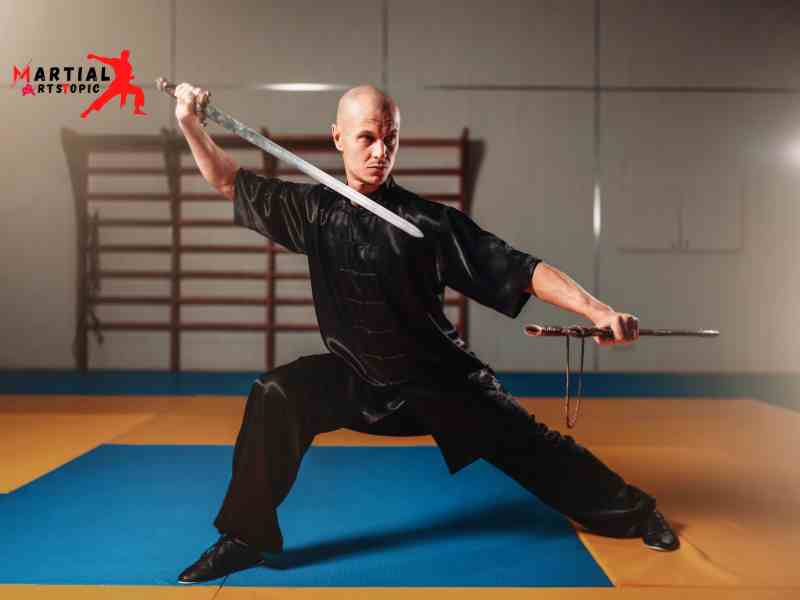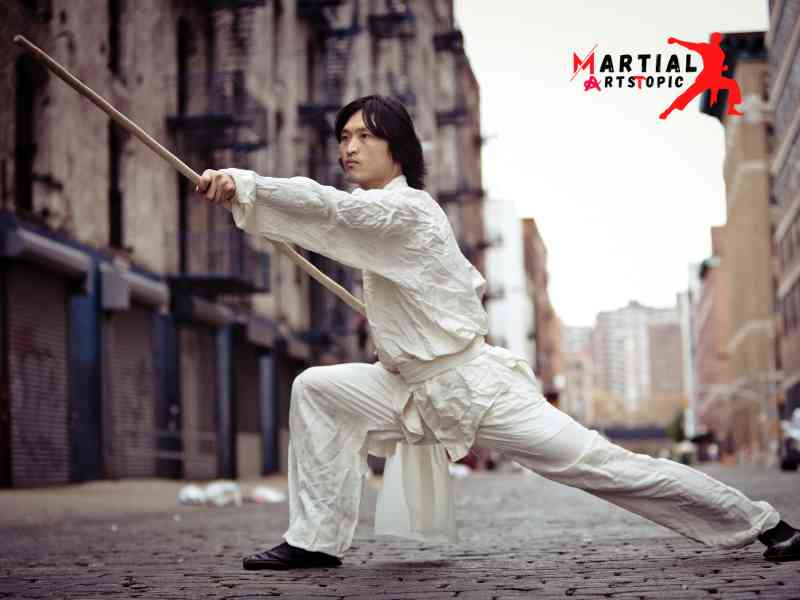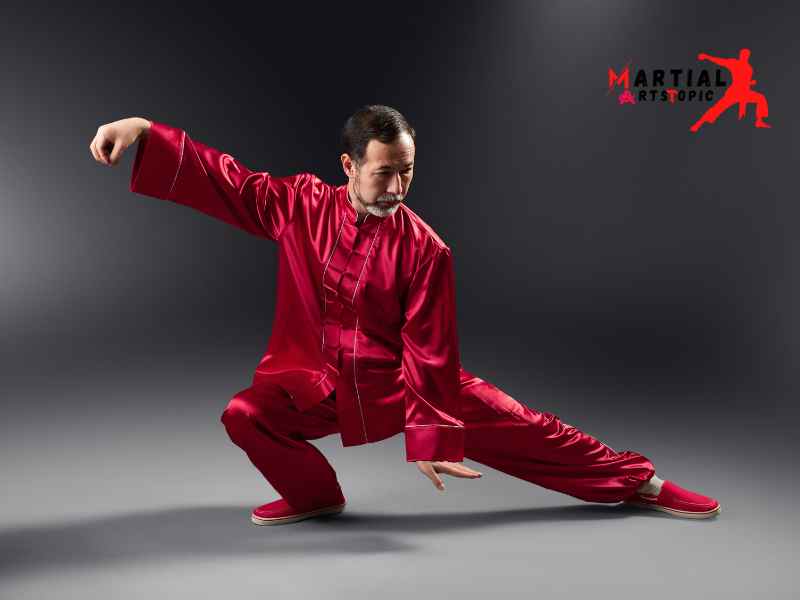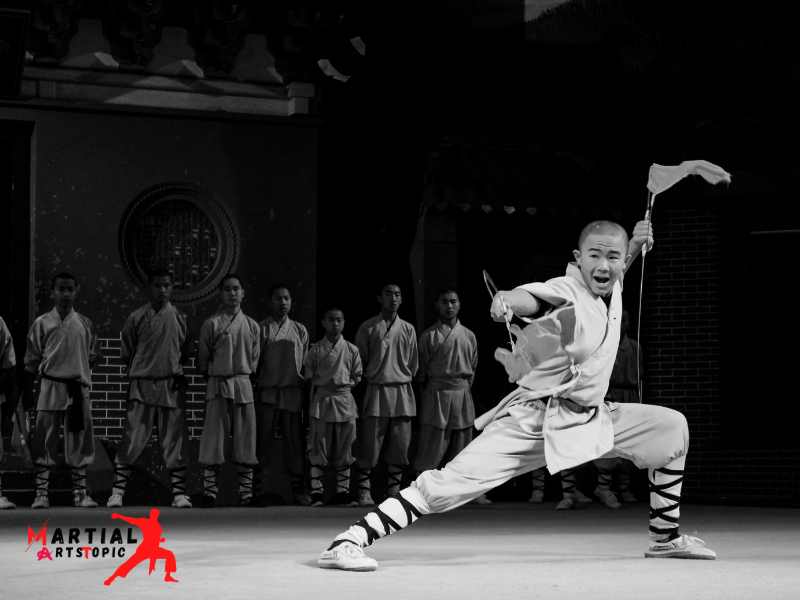
The Martial Art of Wushu
Wushu, also known as Chinese Kung Fu, is a captivating and intricate martial art that has captivated practitioners and spectators alike for centuries. With its graceful and powerful movements, Wushu encompasses a wide range of traditional Chinese martial arts styles and techniques. It emphasizes both physical prowess and mental discipline, making it a holistic form of self-expression and self-improvement. Whether you’re drawn to the flowing, dance-like forms of Tai Chi or the explosive, acrobatic movements of contemporary Wushu, this ancient art offers something for everyone. Its rich history, diverse techniques, and emphasis on both physical and mental development make it a truly fascinating and rewarding martial art to explore.
Styles of Wushu
Wushu encompasses a wide range of styles, each with its own unique characteristics and techniques. Some of the most well-known styles include:
- Changquan: Its long, sweeping movements and powerful kicks characterize this style. It emphasizes speed, agility, and acrobatic techniques.
- Nanquan: Nanquan, or Southern Fist, originated in southern China and is known for its strong strikes. It focuses on close-range combat and quick, explosive movements.
- Taijiquan: Taijiquan, also known as Tai Chi, is a slow and graceful style of Wushu. It emphasizes balance, flexibility, and relaxation, making it popular among people of all ages for its health benefits.
- Baguazhang: Baguazhang is a circular and evasive style that emphasizes continuous footwork and intricate hand techniques. We know it for its fluid movements and unpredictable changes in direction.
Techniques of Wushu
Wushu techniques encompass a wide range of strikes, kicks, throws, and joint locks. Some of the fundamental techniques include:
- Punches: Wushu incorporates a variety of punches, including straight punches, hooks, and uppercuts. They executed these techniques with precision and power, making them effective in both offensive and defensive situations.
- Kicks: Wushu is renowned for its high-flying kicks, which require strength, flexibility, and excellent balance. Kicks such as the sidekick, roundhouse kick, and flying kick are commonly used in Wushu competitions and performances.
- Throws and takedowns: Wushu includes a repertoire of throws and takedowns that allow practitioners to immobilize or subdue their opponents. These techniques require timing, leverage, and a deep understanding of body mechanics.
- Joint locks: Wushu incorporates joint locks to control an opponent’s limbs and manipulate their joints. These techniques can immobilize or disable an attacker without causing permanent harm.
Wushu: Unveiling the Secrets of Chinese Martial Arts

Wushu: Unveiling the Secrets of Chinese Martial Arts in the vast world of martial arts. One style stands out for its grace, precision, and deep-rooted history – Wushu. Originating from China, Wushu has captivated the hearts and minds of people worldwide with its breathtaking displays of athleticism and skill. The secrets of Wushu, exploring its rich heritage, its various forms, and the benefits it offers to both body and mind.
Wushu, often referred to as “Chinese Kung Fu,” encompasses a wide range of martial arts styles that have been developed and practiced in China for centuries. The term “Wushu” itself translates to “martial arts” in Chinese, illustrating the comprehensive nature of this discipline. They do not limit it to combat techniques, but also include elements of self-defense, artistic performance, and physical fitness.
One of the distinguishing features of Wushu is its emphasis on fluid movements and harmonious balance. Practitioners of Wushu train meticulously to achieve a perfect blend of strength, flexibility, and agility, resulting in mesmerizing routines that seem to defy gravity. These routines, known as forms or taolu, showcase a combination of kicks, punches, jumps, and acrobatic maneuvers, all executed with incredible precision and control.
While Wushu’s roots can be traced back to ancient China, it gained significant popularity during the 20th century when it was standardized and promoted as a national sport. Today, it recognized Wushu as both a competitive sport and an art form, attracting practitioners of all ages and skill levels.
We can categorize wushu into two dominant styles – traditional and contemporary. Traditional Wushu focuses on preserving the ancient techniques and cultural heritage of Chinese martial arts. It includes various styles such as Shaolin, Tai Chi, Wing Chun, and many others, each with its unique characteristics and principles.
Contemporary Wushu has evolved to incorporate modern innovations and performance elements. We often saw it in international Wushu competitions, where athletes push the boundaries of human capabilities, executing complex aerial maneuvers and breathtaking displays of athleticism.
Apart from its aesthetic appeal, Wushu offers a multitude of benefits for practitioners. From a physical standpoint, Wushu helps improve cardiovascular health, strength, and flexibility. The demanding training routines enhance endurance, coordination, and body awareness. Regular practice of Wushu can also aid in weight management and overall fitness.
But Wushu is not just about physical prowess. It is a discipline that nurtures the mind and cultivates virtues, such as discipline, respect, perseverance, and humility. Through the rigorous training, practitioners develop mental fortitude, focus, and the ability to overcome challenges. Wushu becomes a path of self-discovery and self-improvement, instilling a sense of confidence and self-belief.
For those interested in delving into the world of Wushu, there are many opportunities available. Many martial arts schools, fitness centers, and Wushu academies offer classes and training programs for beginners and advanced practitioners. Joining a Wushu community provides not only a platform for learning, but also a supportive environment that fosters personal growth and camaraderie.
The History and Evolution of Wushu: From Ancient China to Modern Times
The History and Evolution of Wushu: From Ancient China to Modern Times Wushu, also known as Chinese martial arts, is a rich and ancient tradition that has captivated people around the world for centuries. With its intricate techniques, graceful movements, and profound philosophy, Wushu has become more than just a martial art–it is a way of life.The fascinating history and evolution of Wushu, from its origins in ancient China to its modern-day prominence.
Origins of Wushu Martial Arts
We can trace the roots of Wushu back to ancient China, where it was developed as a means of self-defense and military training. The earliest evidence of Wushu dates back to the Xia Dynasty (c. 2070–1600 BC) and the Shang Dynasty (c. 1600–1046 BC), where martial arts techniques were depicted in ancient artifacts and writings.
During the Zhou Dynasty (c. 1046–256 BC), Wushu evolved into a more organized system. The military class, known as the Warring States Period (c. 475–221 BC), played a significant role in the development of Wushu as they sought to improve their combat skills to gain an advantage in battles.
Evolution of Wushu through the Dynasties

As China entered the dynastic era, each ruling dynasty played a crucial role in shaping the development of Wushu. During the Qin Dynasty (221–206 BC), Emperor Qin Shi Huang standardized martial arts and incorporated them into military training.
The Tang Dynasty (618–907 AD) is considered the golden age of Wushu. It was during this time that Wushu flourished as an art form, with different styles and techniques emerging. Martial arts schools were established, and renowned masters emerged, contributing to the growth and refinement of Wushu.
The Song Dynasty (960–1279 AD) witnessed further development in Wushu. The practice became more widespread, with emphasis on health and self-cultivation rather than just combat. Tai Chi, one of the most popular Wushu styles today, was developed during this period.
Modernization and Standardization
In the early 20th century, China underwent significant social and political changes, which had a profound impact on Wushu. With the fall of the Qing Dynasty and the establishment of the Republic of China, traditional Wushu faced challenges and underwent transformations.
In the 1950s, the Chinese government sought to unify and standardize the diverse styles of Wushu. This led to the creation of modern Wushu, which combined elements from various traditional styles. The emphasis shifted from practical combat to aesthetics and performance, making it more accessible to the public.
Global Popularity and Competitions
In recent decades, Wushu has gained international recognition and popularity. It has become a competitive sport, with athletes from around the world taking part in Wushu competitions. The International Wushu Federation (IWUF) was established in 1990 to promote and govern the sport globally.
Wushu has also made its way into popular culture through movies and television. Films like “Crouching Tiger, Hidden Dragon” and “IP Man” have showcased the beauty and skill of Wushu, further fueling its global appeal.
Today, Wushu continues to strengthen and adapt to the modern world. Millions of people worldwide, both as a martial art and exercise, practice it. Its timeless teachings of discipline, respect, and self-improvement resonate with people of all ages and backgrounds.
In conclusion, the history and evolution of Wushu reflect its deep cultural roots and its ability to adapt to changing times. From its origins in ancient China to its modern-day prominence, Wushu has transcended boundaries and become a symbol of strength, grace, and inner harmony.
So, whether you are a martial arts enthusiast or someone looking to embark on a journey of self-discovery, Wushu offers a pathway to physical and mental well-being. Embrace the legacy of Wushu and let its rich history inspire you on your own martial arts journey.
Wushu for Self-Defense: Techniques and Strategies for Real-Life Situations
Wushu for Self-Defense: Techniques and Strategies for Real-Life Situations in self-defense, many people immediately think of martial arts like karate or jiu-jitsu. However, there is another martial art that is gaining popularity for its effectiveness in real-life situations: Wushu.
Wushu, also known as Chinese Kung Fu, is a traditional Chinese martial art that has a rich history dating back thousands of years. It combines elements of both practical self-defense techniques and artistic movements, making it a versatile and dynamic martial art.
One of the key aspects of Wushu is its focus on speed and agility. Unlike some other martial arts that rely heavily on strength and brute force, Wushu emphasizes quick and precise movements to overcome opponents. This makes it an ideal martial art for self-defense situations where speed and agility can be crucial.
In Wushu, there are various techniques that can be used for self-defense. We know one of the most common techniques as “defense against grabs and holds.” This technique involves using quick and fluid movements to break free from an opponent’s grip and neutralize the threat. By mastering this technique, practitioners of Wushu can effectively defend themselves in situations where an attacker may grab or hold them.
Another important aspect of Wushu for self-defense is its focus on practicality. Unlike some martial arts that may have complicated and intricate movements, they design Wushu techniques to be simple yet effective. This allows practitioners to quickly learn and apply the techniques in real-life situations, where time and precision are often limited.
Wushu also places a strong emphasis on mental and emotional strength. In self-defense situations, it is not just physical strength that matters, but also the ability to remain calm and focused under pressure. Through rigorous training and practice, Wushu practitioners develop the mental discipline needed to stay calm and make split-second decisions in high-stress situations.
In strategies for self-defense, Wushu offers several effective approaches. One they know such strategy as “deflects and counter.” This strategy involves redirecting an opponent’s attack and using their own momentum against them. By effectively deflecting an attack and quickly countering, practitioners of Wushu can turn the tables on their opponents and gain the upper hand in a self-defense situation.
Another strategy commonly used in Wushu for self-defense is known as “multiple strikes.” This strategy involves delivering a series of quick strikes to an opponent, overwhelming them, and creating an opportunity to escape or incapacitate the attacker. By combining speed, precision, and power, practitioners of Wushu can effectively defend themselves against multiple attackers.
Benefits of Practicing Wushu Martial Arts
Benefits of Practicing Wushu, also known as Chinese martial arts, is an ancient practice that combines physical movements and mental discipline. It has been practiced for centuries and has gained popularity worldwide. Not only is Wushu a great way to improve your physical fitness, but it also offers many other benefits. In this blog post, we will explore the various advantages of practicing Wushu.
- Enhances Physical Fitness: Wushu is a highly dynamic and demanding martial art that involves a wide range of movements, including kicks, punches, jumps, and flips. Regular practice of Wushu can significantly improve your cardiovascular endurance, strength, flexibility, coordination, and balance. It provides a full-body workout, helping you build lean muscle mass and burn calories.
- Boosts Mental Well-being: Wushu is not just about physical movements; it also emphasizes mental discipline and focus. Through practicing various forms and techniques, you can develop mindfulness, concentration, and self-control. The meditative aspects of Wushu help reduce stress, improve mental clarity, and enhance overall emotional well-being.
- Self-defense Skills: Wushu is a martial art with practical applications for self-defense. By learning Wushu, you gain effective self-defense techniques that can help you protect yourself in real-life situations. The training involves practicing defensive moves, strikes, and evasive maneuvers, which can boost your confidence and personal security.
- Cultivates Discipline and Perseverance: Wushu requires dedication and commitment to master its techniques and forms. Regular practice teaches discipline, patience, and perseverance. The structured training sessions, repetitive movements, and progressive learning help develop a strong work ethic and a never-give-up attitude that can apply to every aspect of life.
- Improves Focus and Concentration: Wushu training demands mental focus and concentration. By constantly engaging in complex movements, combinations, and routines, you train your mind to stay present and focused, blocking out distractions. This enhanced focus can carry over to other areas of your life, such as work or studies, improving your productivity and overall performance.
- Promotes Cultural Appreciation: something deeply rooted Wushu in Chinese culture and traditions. By practicing Wushu, you not only learn the physical techniques but also gain insights into the rich history, philosophy, and values associated with this ancient martial art. It provides an opportunity to develop a deeper appreciation for Chinese culture and its contributions to the world of martial arts.
- Builds Confidence and Self-esteem: As you progress in your Wushu training, you will notice improvements in your physical abilities and mental fortitude. The mastery of complex movements and the ability to execute them with precision can boost your confidence and self-esteem. This newfound confidence can positively impact various aspects of your life, from personal relationships to professional endeavors.
- Offers a Sense of Community: they often practiced wushu in group settings, allowing individuals to be part of a supportive and motivating community. Training with fellow practitioners creates a sense of camaraderie and fosters social connections. The shared passion for Wushu creates a supportive environment where you can learn from others, exchange knowledge, and inspire each other to reach new heights.
Wushu vs. Other Martial Arts: What Sets It Apart?

Wushu vs. Other Martial Arts: What Makes It Stand Out? In the vast world of martial arts, one discipline that stands out is wushu. With its graceful movements, explosive techniques, and rich cultural heritage, Wushu has captured the hearts and minds of practitioners and spectators alike. But what sets Wushu apart from other martial arts? Let’s dive deeper into this captivating art form and explore its unique characteristics.
Wushu, also known as Chinese Kung Fu, traces its roots back thousands of years to ancient China. It encompasses a wide range of martial arts styles, including both traditional and contemporary forms. What sets Wushu apart is its emphasis on fluidity, precision, and aesthetics. While other martial arts focus primarily on combat effectiveness, Wushu places equal importance on artistic expression and performance.
One of the distinguishing features of Wushu is its acrobatic and highly choreographed routines. Practitioners of Wushu perform intricate movements, showcasing their flexibility, agility, and coordination. These captivating routines often incorporate elements such as jumps, spins, kicks, and flips, creating a visually stunning spectacle. Wushu’s emphasis on performance and aesthetics sets it apart from other martial arts, making it a truly unique art form.
Another aspect that sets Wushu apart is its wide range of weapons’ training. While many martial arts disciplines focus on unarmed combat, Wushu encompasses a multitude of weapons forms. From the elegant and deadly sword to the powerful and versatile staff, practitioners of Wushu master various weapons, adding depth and diversity to their training. Incorporating weapons into Wushu not only enhances combat skills, but also showcases the artistry and craftsmanship behind these weapons.
Wushu’s emphasis on flexibility and agility also distinguishes it from other martial arts. Practitioners of Wushu undergo rigorous training, which includes stretching exercises to enhance their range of motion. This flexibility allows Wushu practitioners to execute complex techniques with ease, making their movements appear effortless and graceful. The combination of power, speed, and flexibility in Wushu sets it apart as a dynamic and awe-inspiring martial art.
Wushu’s rich cultural heritage and deep-rooted traditions make it a truly unique martial art. It embodies the values and philosophies of ancient Chinese culture, reflecting principles such as respect, discipline, and harmony. Wushu practitioners not only train their bodies but also cultivate their minds and spirits, striving to achieve a balance between physical and mental well-being. This holistic approach to martial arts sets Wushu apart from other disciplines, making it a way of life rather than just a combat technique.
The Evolution of Wushu: Traditional vs. Contemporary Styles
Wushu Martial Arts, also known as Chinese martial arts, has a rich history that spans thousands of years. From its origins in self-defense, Wushu has developed into a popular sport and performing art. Today, there are two distinct styles of Wushu that have emerged: traditional and contemporary.
Traditional Wushu, also known as “Kung Fu,” is deeply rooted in Chinese culture and has been practiced for centuries. It focuses on preserving ancient techniques and forms passed down from generation to generation. Traditional Wushu places a strong emphasis on discipline, respect, and mastering the fundamental movements. Practitioners of traditional Wushu often train in temples or dedicated schools, following a structured curriculum that covers a wide range of techniques such as punches, kicks, and grappling.
Contemporary Wushu is a relatively new style that emerged in the late 1940s. They developed it with the goal of creating a standardized form of wushu for competition. Contemporary Wushu places more emphasis on acrobatics, flexibility, and aesthetics. It incorporates flashy kicks, jumps, and spins to create visually stunning performances. Unlike traditional Wushu, which focuses on practical self-defense techniques, they design contemporary Wushu for performance on stage or in tournaments.
One of the major differences between traditional and contemporary Wushu lies in their training methods. Traditional Wushu emphasizes building a firm foundation through repetitive practice of basic movements and forms. It prioritizes internal development, focusing on cultivating inner strength, balance, and breath control. Contemporary Wushu places more emphasis on external aesthetics and requires athletes to possess greater physical flexibility and agility.
In terms of techniques, traditional Wushu often incorporates a wide variety of martial arts styles, including animal imitations, weapon forms, and qigong exercises. They deeply rooted these techniques in Chinese philosophy, folklore, and mythology. Contemporary Wushu has adopted a more standardized approach. It has a set of compulsory and optional routines that athletes must perform in competitions. These routines are carefully choreographed and judged based on specific criteria, such as difficulty, execution, and presentation.
Its transition from a traditional martial art to a modern sport has greatly influenced the evolution of Wushu. While traditional Wushu focuses on preserving ancient techniques and cultural heritage, contemporary Wushu has embraced innovation and creativity to captivate audiences worldwide. Both styles have their unique strengths and appeal to different practitioners.
In conclusion
Wushu Martial Arts: Wushu is a captivating martial art that encompasses both physical prowess and deep-rooted cultural traditions. With its diverse range of techniques and styles, Wushu offers practitioners a holistic approach to self-defense, physical fitness, and spiritual growth. Through diligent practice and discipline, individuals can cultivate not only their physical strength but also their mental focus and emotional balance. Wushu serves as a powerful tool for promoting cultural exchange and understanding, as its rich history and artistic elements continue to captivate people from all walks of life. Whether one pursues Wushu for sport, self-defense, or personal development, its enduring legacy and timeless principles make it a truly remarkable martial art.
